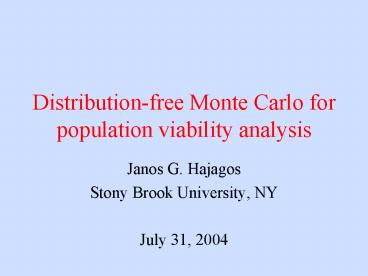Distributionfree Monte Carlo for population viability analysis - PowerPoint PPT Presentation
1 / 14
Title:
Distributionfree Monte Carlo for population viability analysis
Description:
Distribution-free Monte Carlo for population viability analysis. Janos G. Hajagos ... Carlo is conservative no need for biased sampling (e.g. Latin hypercube sampling) ... – PowerPoint PPT presentation
Number of Views:63
Avg rating:3.0/5.0
Title: Distributionfree Monte Carlo for population viability analysis
1
Distribution-free Monte Carlo for population
viability analysis
- Janos G. Hajagos
- Stony Brook University, NY
- July 31, 2004
2
Two types of uncertainty
- Epistemic is uncertainty in knowledge.
- It can be reduced
- Modeled with intervals or subjective probability
- Stochastic is inherent uncertainty in a process.
- It cannot be reduced
- Modeled with random variables
3
Interval Analysis
In interval analysis the atomic unit in the
calculation is the interval.
4
Interval Arithmetic
Addition a,bc,d ac,bd. Multiplication
a,bc,d min(ac,ad,bc,bd),
max(ac,ad,bc,bd). The function exp exp(a,b)
exp(a),exp(b).
5
Intervalized model of growth
6
Stochastic population growth
where normal() generates a normal deviate with an
average growth rate (rln(R)) and sr is the
standard deviation of the growth rate.
7
Second-order Monte Carlo
- What if we dont know the exact value of or
s? - We can guess the value
- Or we can sample from a second statistical
distribution - If we only know the range of the value then we
can sample the value from a uniform distribution.
8
Sampling from a uniform distribution
Twenty random samples from uniform(2,3) 1
2.041 2.078 2.193 2.201 2.295 2.311 2.545 2.548
9 2.571 2.590 2.594 2.596 2.650 2.767 2.775
2.840 17 2.874 2.893 2.915 2.915
9
Two models
Model I
Model II
10
A single realization
Model I.
Model II.
11
Quasi-extinction decline curves
12
Comparison to second-order
Model parameters N90,110 r-0.05,0.1 s0.05,
0.2 T20 years 1000 runs 100 inner samples
13
Implications for PVA
- Need to account for uncertainty in estimation of
risk parameters. - Second-order Monte Carlo can underestimate bounds
on extinction risk. - Interval Monte Carlo offers an alternative with
no additional distributional assumptions. - Interval Monte Carlo is conservative no need for
biased sampling (e.g. Latin hypercube sampling)
14
Acknowledgements
- Lev Ginzburg of Stony Brook University
- Scott Ferson of Applied Biomathematics































